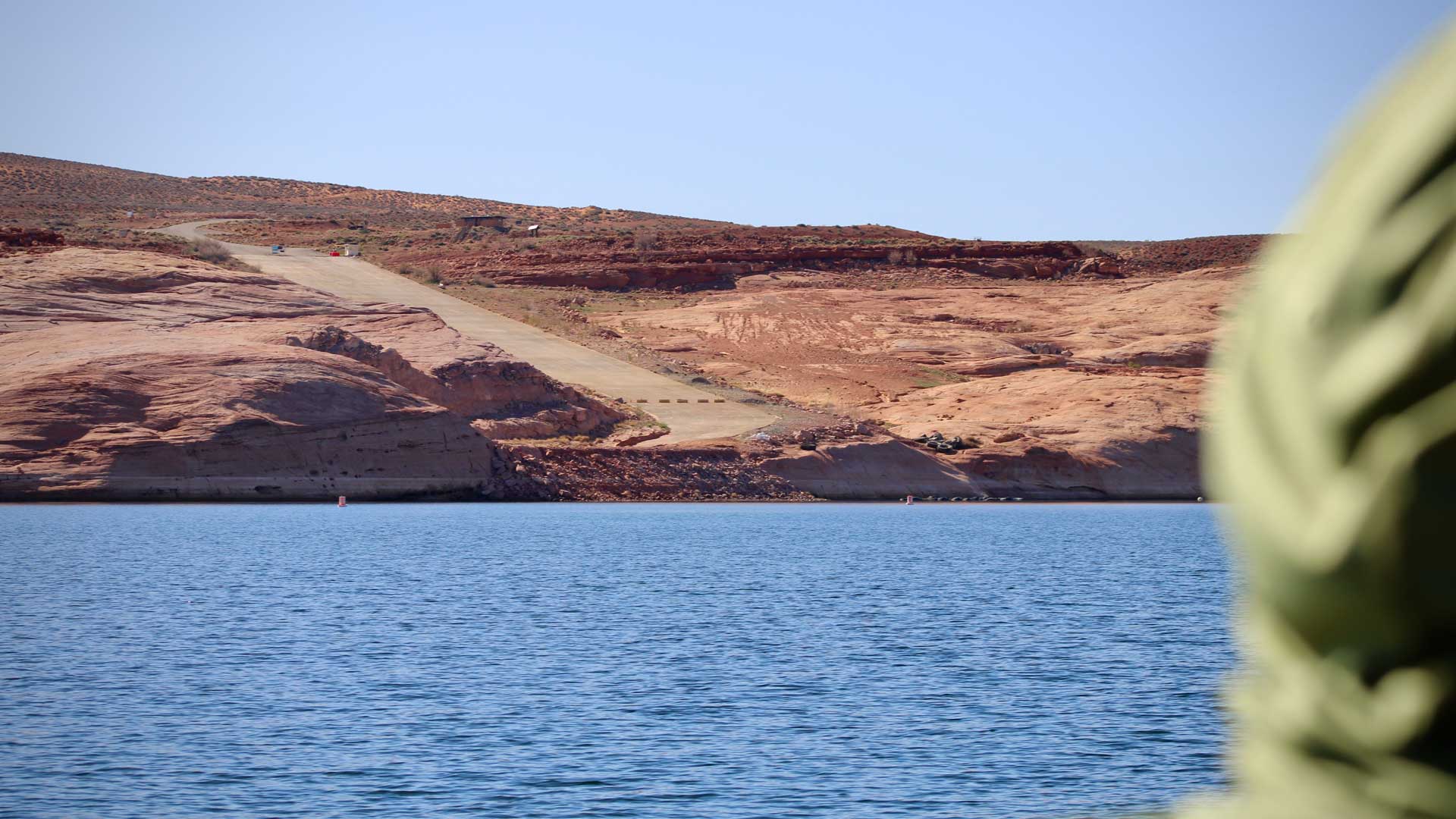 A boat ramp, once partially submerged under Lake Powell, sticks out of the water on April 10, 2023. The nation's second-largest reservoir, which is filled by the Colorado River, has reached record low levels in recent years. Policymakers are stuck in a standoff about how to reduce demand on the reservoir and river.
A boat ramp, once partially submerged under Lake Powell, sticks out of the water on April 10, 2023. The nation's second-largest reservoir, which is filled by the Colorado River, has reached record low levels in recent years. Policymakers are stuck in a standoff about how to reduce demand on the reservoir and river.
In tense talks over the future of the Colorado River, policymakers are focused on the year 2026. That’s when current rules for managing the river expire, and the seven states that use its water will have to agree on new ones. But now, with an approaching deadline on March 11 to agree on a first draft of new rules, those states are far from consensus on how to manage the shrinking river in the future.
Water negotiators from states around the Southwest said they are planning to submit separate proposals about managing the Colorado River after 2026 to the Bureau of Reclamation, the federal agency that manages rivers and dams in the Western U.S.
The split is the latest flareup between the Colorado River’s Upper Basin states of Colorado, Utah, Wyoming, and New Mexico, and the Lower Basin states of California, Arizona, and Nevada.
“We've had to come together on our own in the Upper Basin and work on a concept that provides for sustainable operations that's both technically and economically feasible,” Becky Mitchell, Colorado’s top water negotiator, said.
The Upper Basin and Lower Basin states have gone back and forth about how to share water for over a century, and have especially struggled to come to agreements during the past few years. Climate change is steadily shrinking the Colorado River’s supply, and leaders from those states have been caught in a standoff about how to rein in demand in response.
Meanwhile, the river’s two largest reservoirs – Lake Powell and Lake Mead – have shrunk to record lows in the past two years. Images of the beleaguered reservoirs, the nation’s two biggest, have become a stark symbol of the supply-demand imbalance that threatens the water supply for 40 million people and a multibillion-dollar agricultural industry.
The process to hash out new rules for the river is a slow one, as policymakers aim to divvy up the shrinking river while still considering the interests of cities, farms, tribes, environmental groups, and others. Because of that, leaders in Washington, D.C., and around the Southwest have been aiming to get proposals in writing by mid-March.
The deadline is an effort to get the ball rolling on new river rules with enough time to implement them before a potential change in administration after the upcoming November election.
One major tension point between the two factions regards the Upper Basin states’ legal obligation to send a fixed amount of water to Lower Basin neighbors.
But the Upper Basin states argue they feel a disproportionate sting during dry winters when less snow falls in the mountains where the Colorado River begins. Now, the Upper Basin's leaders are floating the idea of sending less water downstream because of a trend of drier winters fueled by climate change.
“We're committed to remaining at the table and trying to seek consensus on a seven-basin state alternative,” Colorado’s Becky Mitchell said. “We have to acknowledge, though, the pain that is inherent with living on the front lines of climate change.”
The Upper Basin states’ suggestion of sending less water to the Lower Basin states exists in murky legal territory.
The language of the 1922 legal agreement that sets the table for today’s Colorado River management says, “The States of the Upper Division will not cause the flow of the river… to be depleted” below an established amount.
The Upper Basin states are now suggesting they could allow less water to pass downriver because climate change is causing the lower flows, not water use by the states themselves. The idea has not yet been tested in court, and Lower Basin leaders say their counterparts’ proposals aren’t practical.
“If every position is hardened and predicated on legal theories and interpretations, that's not carrying us forward in a productive direction,” JB Hamby, California’s top water negotiator, said.
Even though these first draft proposals reveal the lingering divisions between states that must decide the river’s future, experts say there’s still a possibility that the gap can be closed.
“I increasingly am of the mindset that this is a necessary step before they find common ground,” Elizabeth Koebele, an assistant professor of political science at the University of Nevada, Reno, said.
Koebele, whose work focuses on the politics of Colorado River management, said these kinds of negotiations used to happen behind closed doors. But now, with higher stakes and increased attention on the Colorado River, these tussles are playing out in the public eye.
“Everyone needs to put what they want most on the table, and then kind of negotiate back from there,” she said.
Water leaders themselves are hinting at optimism about finding agreement down the road.
“There is an intent, certainly on our part, once we do do those initial submissions, to get back together and try and work through our differences and hopefully be able to arrive at a consensus alternative,” Estevan López, New Mexico’s water negotiator, said.
This story is part of ongoing coverage of the Colorado River, produced by KUNC in Colorado and supported by the Walton Family Foundation. KUNC is solely responsible for its editorial coverage.

By submitting your comments, you hereby give AZPM the right to post your comments and potentially use them in any other form of media operated by this institution.